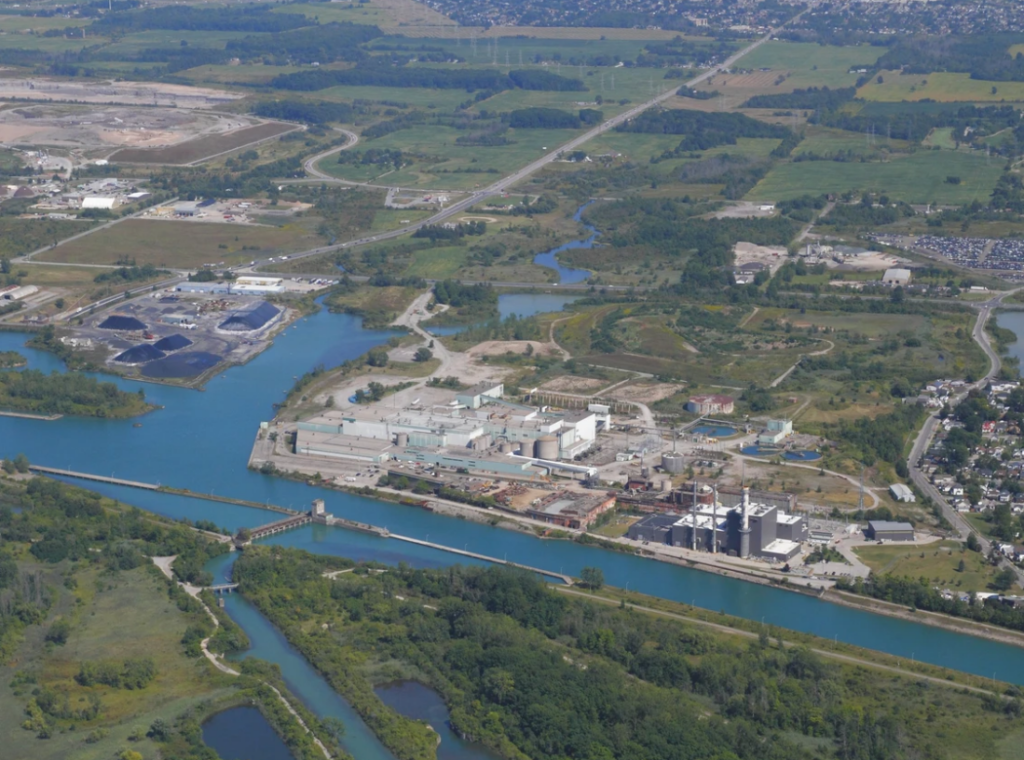The original publication of this article was published on The National Post on November 18, 2022 and can be viewed here.
You can see it for miles in almost every direction: a hulking, green-walled former paper mill located alongside the Welland Canal in Thorold, Ontario, in the centre of the Niagara Region. The 200-acre site is so enormous that it has its own rail line, dock wall for ships, power plant, water treatment plant and even a baseball diamond. The company baseball team is long gone, along with the papermaking; after a series of ownership changes, the paper mill finally closed its doors for good in 2016.
Purchased in 2020 by Bioveld Canada, the new owner reached out to partner with the Hamilton-Oshawa Port Authority (HOPA Ports) to reimagine the space. “The sheer scale of it was daunting at first,” recalls HOPA’s Commercial vice president, Jeremy Dunn. “But as you make your way through the buildings, storage areas, warehouses and offices, the opportunity becomes clear.”
Bioveld and HOPA Ports re-launched the space as the “Thorold Multimodal Hub,” a modern industrial “ecosystem” which could meet the needs of multiple new tenant businesses. “Modern industries tend to have smaller footprints, but they are also finding it difficult in southern Ontario to find the mix of advantages we have here, like development land, warehousing space, transportation and supply chain supports, and ample hydro power,” said Dunn. Less than two years on, more than a dozen businesses now call the Thorold Hub home, and the space is integrated with HOPA’s nearby bulk material facility.
The Thorold Hub is also now part of HOPA Ports’ southern Ontario-wide network, which includes the ports of Hamilton and Oshawa, as well as an emerging hub in Port Colborne. In all, HOPA’s network includes over 1,000 acres of multimodal-served land, which is home to more than 140 businesses.
HOPA’s southern Ontario facilities share important advantages, including their robust transportation assets, a synergistic community of industrial users, and the support of HOPA’s team of experts in optimizing modern industrial spaces.
“We know that when a business looks at its overall supply chain costs, transportation makes the greatest impact by far – even more than rent – so that’s where HOPA can develop solutions that add extraordinary value,” said Dunn.
In Thorold, the Hub’s marine, rail and highway access have been critical in attracting tenants like Canadian Maritime Engineering and CHAR Technologies. Thorold’s location, which is on the doorstep of the Greater Toronto Hamilton Area and less than an hour’s drive to the US border, also provides a competitive advantage for companies facing increasing trucking costs.
As the redevelopment of the site continues, new indoor and outdoor spaces are becoming available, ideal for warehousing and transloading of goods, including liquid bulk and breakbulk products like heavy steel. The space is also well-suited to manufacturers who would benefit from access to the on-site energy infrastructure.
“We see tremendous potential for businesses looking to expand in a cost-effective way,” said Dunn. “In addition, Niagara’s proximity to the United States and the industrial know-how of people in the region is very strong. It’s a great place for businesses who require skilled workers to relocate.”
Niagara was historically part of Ontario’s industrial heartland, and it still boasts a huge supply of skilled labour with decades of manufacturing experience.
The region also boasts two world-class post-secondary institutions — Brock University in St. Catharines and Niagara College in Welland — that produce leaders in business, manufacturing, communications, and many other disciplines.
“Both are strategically located within the region and will produce the next generation of employees,” said George Spezza, director of Economic Development for Niagara Region.
“The university and the college can work directly with major employers to ensure they’re providing the skills, the education and the resources needed to scale up the workforce of the future for industry.”
Niagara Region Economic Development has incentives for new industrial tenants, and it provides an end-to-end concierge-style service that helps set businesses to establish themselves. Additional ongoing supports from Niagara Region help companies throughout their lifecycles.
“What really adds to our value proposition is: It’s not only a competitive place to do business, but it’s a really great place to live as well,” said Spezza.
“The quality of life is really second to none. It has the benefits of being close to Toronto, but also has many of the cultural benefits, the sporting and leisure benefits you would want in moving to the region, working and playing in the region as well.”
HOPA’s Jeremy Dunn believes the reinvention of the Thorold Hub is a perfect example of Niagara region’s creative energy. “There’s a momentum here that’s really exciting. There’s a supportive business and civic environment, and when you have those partnerships it makes big things possible.”
For more information about locating or expanding a business in the HOPA network, visit hopaports.ca or call 905-525-4337.
This story was created by Content Works, Postmedia’s commercial content division, on behalf of HOPA Ports.

